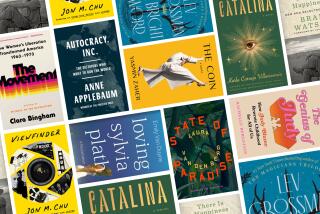The ‘Dumbing Down’ of Children’s Lit
- Share via
Call it the Mystery of the Missing Brain Matter. Here’s the plot: Frank and Joe Hardy, a.k.a. “The Hardy Boys,” notice that much of the character description, good chunks of story line and lots of dialogue have disappeared from volumes of their popular adolescent detective novels.
“What gives, Joe?” Frank wonders.
For the record:
12:00 a.m. June 3, 1991 For the Record
Los Angeles Times Monday June 3, 1991 Home Edition View Part E Page 2 Column 4 View Desk 1 inches; 30 words Type of Material: Correction
Magazine contents--In Thursday’s View, the magazines column misattributed two articles. “Reading May Be Harmful to Your Kids” appears in Harper’s. “Disimproving the Hardy Boys” appears in Atlantic Monthly.
The case is solved, sort of, in the Reports and Comment section of the June Harper’s. It seems that way back in 1959, the president of the syndicate that owned the Hardy Boys and Nancy Drew series ordered the books revised. The result, according to Harper’s writer Cullen Murphy, was a subtle dumbing down of the series.
Little remained in the books to discomfit anyone after their revision, “such as dialogue rendered in dialect, humor at the expense of policemen and big words that might have to be looked up.”
No one has ever claimed that the Hardy Boys or Nancy Drew were great literature, but Murphy makes a good case that the old versions were “good bad books” and that the newer fare is mediocre bad fiction at best. His only comfort is that the publisher is re-releasing the first three volumes in the series in original form.
Meanwhile, right next door in the quasi-intellectual section of the news rack, the June Atlantic Monthly takes the case against diluting kiddie fiction a step further with a broadside against the state of contemporary children’s and young adults’ books.
The author, Tom Engelhardt, is strangely snitty about yupparents who think that reading will make their kids better people--the nerve of them elitists!--and that gives the essay a peculiarly uneven tone. But his key point is an interesting one: Encouraging reading is not necessarily virtuous per se.
Kiddie books are big business now. As such they’re often marketed as mere merchandise--flashy packages with vacuous contents, carefully designed for media-addled young minds--that are then spun off into audio, video, play and fashion gimmicks.
“The descent of adult methods into children’s publishing has also meant the descent of junior versions of distinctly adult genres--the TV soap opera, the woman’s romance, the thriller--deeper and deeper into the world of childhood; and with them, a certain generic sameness has blanketed bestsellerdom,” he says.
Style has given way to blandness. Characters have become pseudo-psychological types. Plot revolves around anxiety and reassurance and values are portrayed with amazing frequency, he writes, based on characters’ shopping habits-- how they behave at the local mall.
Teen-age Mutant Ninja Turtles, the New Kids on the Block and the sanctimonious Berenstain Bears have driven most quality children’s fiction off the bestseller lists. This has Engelhardt worried.
One response is that some weeks the literary quality of the adult bestseller list would be elevated by the arrival of a Ninja Turtle or two. Yet there’s a solid core of fine literature being written and read by adults that never makes any list.
Same thing with kiddie lit. That “Charlotte’s Web” and “Where the Wild Things Are” were 15 and 20 on the bestseller list last year is a good sign, right? Sure, Engelhardt would say. But that’s not the point. As adult marketers shove their crassly adultish ideas into kids’ heads, they clutter young imaginations, forcing out childhood.
The saddest thing about this, he writes, “is simply that children, buying these books, have no way of knowing that they are being shortchanged by grown-ups; for where children are deepest, least reachable, most unnerving, is exactly where this world of books is becoming shallower, more obvious, more expectable and yet is weighing more heavily on the young.”
With that hide-and-seek Waldo as a prime role model these days, is it any wonder that one in five people seek professional help before reaching adulthood? Parents who catch their kids reading a bestseller may want to turn back to the Atlantic, where the cover story for June is an extensive and excellent overview of child therapy.
REQUIRED READING
Norplant is a neat little contraceptive that is embedded in a woman’s arm. Unwanted children are a major problem in this country--maybe the major problem, considering their potential social, economic and environmental impact. So does society have a right, an obligation, to use Norplant as a tool for solving its myriad ills?
The June Mirabella investigates that question in all its volatile complexity. Author Ellen Hopkins offers no solid answers to the debate but stirs things up sufficiently well that readers may decide to step back from the prevailing orthodoxies on the issue and think for themselves.
* As anyone with his feet on the Earth knows by now, green gardening has new connotations these days. The June Consumer Reports does its rating thing on mulching mowers and chipper/shredders and offers a guide to common garden problems and environmentally sound solutions to them.
SHREDDER FODDER
Boys! Stop that, boys!
GQ, usually so suave and, well, gentlemanly, starts off its June issue with a screeching cat fight. In March, GQ writer Alan Richman profiled macho actor Steven Seagal. Seems Seagal wasn’t flattered. So he goes on “Arsenio” and “in his charmingly inarticulate manner,” according to GQ Editor-in-Chief Art Cooper, calls Richman “a 5-foot-2 fat little male impersonator.”
Now Cooper feels obliged to defend his writer’s honor. That’s gentlemanly. But his manner is less so. First he sets the record straight on the issue of Richman’s size and mentions the bronze star he won in Vietnam. Then Cooper slaps back:
“When Mr. Seagal showed up to have his picture taken for the cover of this magazine . . . his jet-black hair seemed to have a slick coating of shoe polish, and he was wearing a hair net. . . . Mr. Seagal was wearing more pancake makeup than Tammy Faye Bakker on her very best day. So, I ask you, who is calling whom a male impersonator.”
More to Read
Sign up for our Book Club newsletter
Get the latest news, events and more from the Los Angeles Times Book Club, and help us get L.A. reading and talking.
You may occasionally receive promotional content from the Los Angeles Times.






